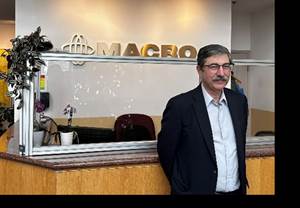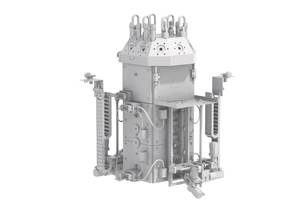New Barrel Heater/Cooler Saves ‘Juice' to Run an Extruder
New, patent-pending design is said to reduce both radiant and convection heat losses.
A new extruder barrel heater/cooler design has been shown to cut energy consumption by as much as 33% over typical designs.
Developed by Davis-Standard LLC, Pawcatuck, Conn. (davis-standard.com), and dubbed the “energy-efficient, air-cooled, electrically heated” (EEACEH) system, the new, patent-pending design is said to reduce both radiant and convection heat losses.
In a typical single-screw extruder with an air-cooled, electrically heated (ACEH) barrel, when heat is required to control the temperature of a barrel zone, electricity is supplied and is dissipated as heat energy. When heat must be removed from the barrel, a fan drives air over the external finned surface of the barrel.
With the EEACEH design, convective losses are reduced by a damper valve system that is incorporated into the exhaust section of the heater/cooler (see illustration). This reportedly prevents free convection of air over the surface of the heater when the barrel zone requires heating.
When the zone requires heating, the damper is in the normally closed position. When cooling is required, air pressure opens the damper to allow the heated air to escape. The radiant energy losses from the surface of the heater cooler are reduced through the use of insulation on the outer shell of the shroud assembly and the leading and trailing faces of the cast heater/cooler.
At its lab facility in Pawcatuck, Davis-Standard ran tests comparing the performance of a typical system vs. the new-generation heating/cooling technology. The test unit consisted of one zone of a 4.5-in. single-screw extruder. The heater/cooler mounted on the cylinder had a 4:1 L/D, with a maximum heating capacity of approximately 16 kW. A blower was connected to the cooling shroud to provide forced-air cooling when required.
The control thermocouple was placed 0.100 in. from the barrel ID, and the heater thermocouple was located in the middle of the cast heater wall. A PID temperature controller was used to control the barrel temperature of the deep thermocouple setpoint. A 4.5-in., square-pitch metering screw with a channel depth of 0.3 in. was fitted in the barrel. This provided a helical channel for circulating the heat transfer fluid that was used to simulate the internal temperature of the extrusion process. To simulate high-temperature extrusion, an oil circulation system provided a constant-temperature supply of heat-transfer fluid to the unit at a constant flow rate of 40 liters/min.
Each heater configuration was tested over a range of operating conditions. For each data set, the internal oil temperature, representing the internal temperature of the extrusion process, was held constant, and the barrel-zone temperature was increased in steps. At each steady-state condition the barrel temperature, heater temperature, and electrical power consumption were recorded.
The electrical energy usage for each condition was measured with a Fluke 435 Power Quality Analyzer (PQA). Additional data recorded at each steady-state condition included the voltage and current for each leg; the total actual, active, and reactive power for the system; and the system’s power factor as a function of time.
Electrical power use for each condition was logged at 0.5-sec intervals for 30 min of operation at each steady-state condition, and the results were then averaged.The measurements were bound by the maximum kW heating capacity of the cast heater/cooler and the 750 F maximum temperature limit of the aluminum heater/cooler.
In the test, Davis-Standard plotted the power consumption against the barrel temperature setpoint for each design. The results indicated that EEACEH design maintained the barrel temperature setpoint using less electrical energy than the conventional design for a given internal process temperature. For example, at a process temperature of 500 F, the conventional heating/cooling system consumed nearly 12 kW to maintain barrel setpoint. The EEACEH design consumed 8 kW.
WHAT THIS REALLY MEANS
To hone in on what these savings mean in the real-world of processing, Davis-Standard used data for an extrusion coating line running a 4.5-in., 30:1 extruder with a conventional heating/cooling system, processing a 7-MI LDPE at 595 lb/hr and 140 rpm. The total heater electrical power required for the process was 44.2 kW. Over 8000-hr/yr operation, the barrel heaters would consume 353,600 kWh of electricity.
Using an EEACEH design in place of the conventional ACEH in this setup would result in expected energy savings of about 30%, or 106,080 kWh. Using an average energy cost of 10¢/kWh, this would result in annual cost savings of $10,608.
Davis-Standard discussed this development at a paper coauthored by John Christiano, Norton Wheeler, and Jason Baird and presented at the SPE ANTEC meeting this past spring in Boston.
Related Content
PTi Makes Changes in Leadership Structure
Moves aimed at bolstering the future of the sheet extrusion manufacturer.
Read MoreMacro Names Anzini Tech Sales Manages for Southeast
Has worked in technical roles for leading processing companies in his career of 40+ years.
Read MoreHow to Effectively Reduce Costs with Smart Auxiliaries Technology
As drying, blending and conveying technologies grow more sophisticated, they offer processors great opportunities to reduce cost through better energy efficiency, smaller equipment footprints, reduced scrap and quicker changeovers. Increased throughput and better utilization of primary processing equipment and manpower are the results.
Read MoreRead Next
Lead the Conversation, Change the Conversation
Coverage of single-use plastics can be both misleading and demoralizing. Here are 10 tips for changing the perception of the plastics industry at your company and in your community.
Read MoreUnderstanding Melting in Single-Screw Extruders
You can better visualize the melting process by “flipping” the observation point so that the barrel appears to be turning clockwise around a stationary screw.
Read MorePeople 4.0 – How to Get Buy-In from Your Staff for Industry 4.0 Systems
Implementing a production monitoring system as the foundation of a ‘smart factory’ is about integrating people with new technology as much as it is about integrating machines and computers. Here are tips from a company that has gone through the process.
Read More



















.png;maxWidth=300;quality=90)
(1)2.png;maxWidth=300;quality=90)







